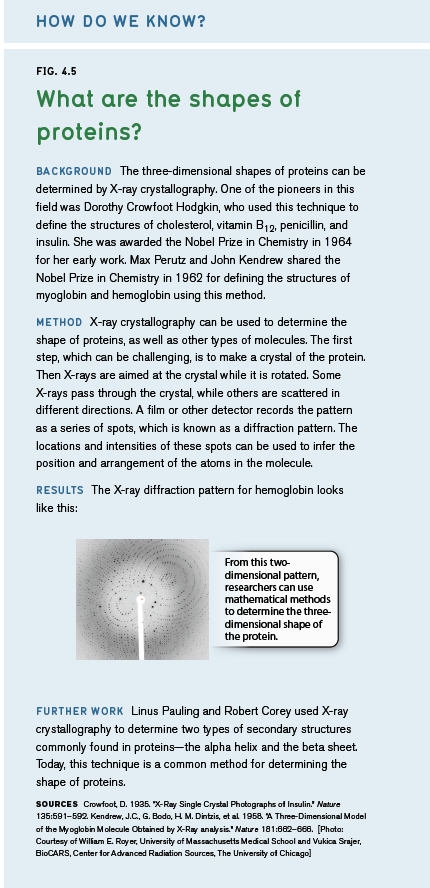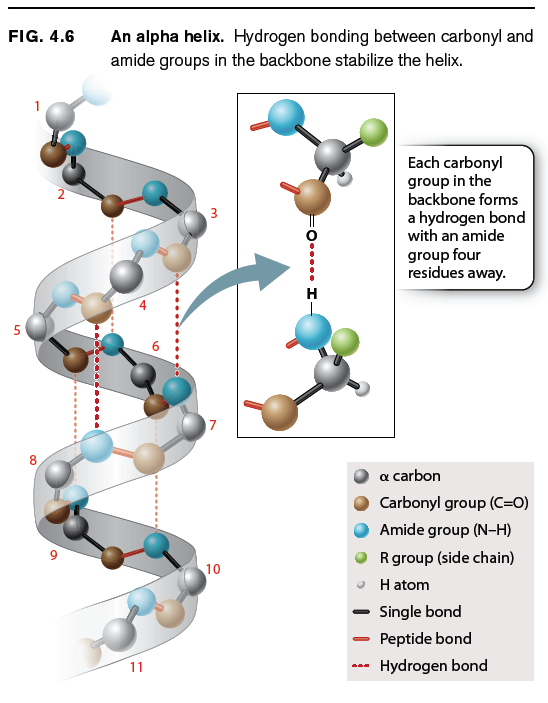How Do We Know? What are the shapes of proteins?

4.1.4 Secondary structures result from hydrogen bonding in the polypeptide backbone.
Hydrogen bonds can form between the carbonyl group in one peptide bond and the amide group in another, thus allowing localized regions of the polypeptide chain to fold. This localized folding is a major contributor to the secondary structure of the protein. In the early 1950s, American structural biologists Linus Pauling and Robert Corey used a technique known as X-ray crystallography to study the structure of proteins. This technique was pioneered by British biochemists Dorothy Crowfoot Hodgkin, Max Petrutz, and John Kendrew, among others (Fig. 4.5). Pauling and Corey studied crystals of highly purifi ed proteins and discovered that two types of secondary structure are found in many di erent proteins. These are the alpha helix and the beta sheet. Both these secondary structures are stabilized by hydrogen bonding along the peptide backbone.
In the alpha helix shown in Fig. 4.6, the polypeptide backbone is twisted tightly in a right-handed coil with 3.6 amino acids per complete turn. The helix is stabilized by hydrogen bonds that form between each amino acid’s carbonyl group and the amide group four residues ahead in the sequence, as indicated by the dashed lines in Fig. 4.6. Note that the side chains project outward from the alpha helix. The chemical properties of the projecting side chains largely determine where the alpha helix is positioned in the folded protein, and how it might interact with other molecules.

The other secondary structure that Pauling and Corey found is the beta sheet, depicted in Fig. 4.7. In a beta sheet, the polypeptide folds back and forth on itself, forming a pleated sheet that is stabilized by hydrogen bonds between carbonyl groups in one chain and amide groups in the other chain across the way (dashed lines). The side chains (shown in green) project alternately above and below the plane of the beta sheet. Beta sheets typically consist of 4 to 10 polypeptide chains aligned side by side, with the amides in each chain hydrogen-bonded to the carbonyls on either side (except for those at the edges).
Beta sheets are typically denoted by broad arrows, where the direction of the arrow runs from the amino end of the polypep-tide segment to the carboxyl end. In Fig. 4.7, the arrows run in opposite directions, and the polypeptide chains are said to be antiparallel. Beta sheets can also be formed by hydrogen bonding between polypeptide chains that are parallel (pointing in the same direction). However, the antiparallel confi guration is more stable because the carbonyl and amide groups are more favorably aligned for hydrogen bonding.
4.1.5 Tertiary structures result from interactions between amino acid side chains.
The tertiary structure of a protein is the three-dimensional conformation of a single polypeptide chain, usually made up of several secondary structure elements. The shape of a protein is defined largely by interactions between the amino acid side chains. By contrast, the formation of secondary structures discussed earlier relies on interactions in the polypeptide back-bone and is relatively independent of the side chains. Tertiary structure is determined by the spatial distribution of hydrophilic and hydrophobic side chains along the molecule, as well as by different types of chemical bonds and interactions (ionic, hydrogen, and van der Waals) that form between various side chains. The amino acids whose side chains form bonds with each other may be far apart in the polypeptide chain, but can end up near each other in the folded protein. Hence, the tertiary structure usually includes loops or turns in the backbone that allow these side chains to sit near each other in space and for bonds to form.
The three-dimensional shapes of proteins can be illustrated in different ways, as shown in Fig. 4.8. A ball-and-stick model (Fig. 4.8a) draws attention to the atoms in the amino acid chain. A ribbon model (Fig. 4.8b) emphasizes secondary structures, with alpha helices depicted as twisted ribbons and beta sheets as broad arrows. Finally, a space-fi lling model (Fig. 4.8c) shows the overall shape and contour of the folded protein.
Remember that the folding of a polypeptide chain is deter-mined by the sequence of amino acids. The primary structure determines the secondary and tertiary structures. Furthermore, tertiary structure determines function because it is the three-dimensional shape of the molecule—the contours and distribution of charges on the outside of the molecule and the presence of pockets that might bind with smaller molecules on the inside—that enables the protein to serve as structural support, membrane channel, enzyme, or signaling molecule. Fig. 4.9 shows the tertiary structure of a bacterial protein that contains a pocket in the center in which certain side groups can form hydrogen bonds with a specific small molecule and hold it in place.
The principle that structure determines function can be demonstrated by many observations. For example, most proteins can be unfolded, or denatured, by chemical treatment or high temperature, and under these conditions they lose their functional activity; but when the chemicals are removed or the temperature reduced, the proteins refold and their functional activity returns. Similarly, mutant proteins containing an amino acid that prevents proper folding are often devoid of their functional activity.
4.1.6 Polypeptide subunits can come together to form quaternary structures.
Although many proteins are complete and fully functional as a single polypeptide chain with a tertiary structure, there are many other proteins that are composed of two or more polypeptide chains or subunits, each of which has a tertiary structure, and that also come together to form a higher-order quaternary structure. In the case of a multi-subunit protein, the activity of the complex depends on the quaternary structure formed by the combination of the various tertiary structures.
The polypeptide subunits may be identical or different (Fig. 4.10). Fig. 4.10a shows an example of a protein produced by HIV that consists of two identical polypeptide subunits. By contrast, many proteins, such as hemoglobin shown in Fig. 410b, are composed of di erent subunits. In either case, the subunits can infl uence each other in subtle ways and infl uence their function. For example, the hemoglobin in red blood cells that carries oxy-gen has four subunits. When one of these binds oxygen, a slight change in its structure is transmitted to the other subunits, making it easier for them to take up oxygen. In this way, oxygen transport from the lungs to the tissues is improved.
4.1.7 Chaperones help some proteins fold properly.
The amino acid sequence (primary structure) of a protein determines how it forms its secondary, tertiary, and quaternary structures. For about 75% of proteins, the folding process takes place within milliseconds as the molecule is synthesized. Some proteins fold more slowly, however, and for these molecules folding is a dangerous business. The longer these polypeptides remain in a denatured state, the longer their hydrophobic groups are exposed to other macromolecules in the crowded cytoplasm. The hydrophobic e ect, along with van der Waals interactions, tends to bring the exposed hydrophobic groups together, and their inappropriate aggregation may prevent proper folding. Correctly folded proteins can sometimes unfold because of elevated temperature, for example, and in the denatured state they are subject to the same risks of aggregation.
Cells have evolved proteins called chaperones that help protect slow-folding or denatured proteins until they can attain their proper three-dimensional structure. Chaperones bind with hydrophobic groups and nonpolar side chains to shield them from inappropriate aggregation, and in repeated cycles of binding and release they give the polypeptide time to find its correct shape